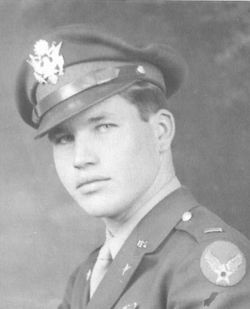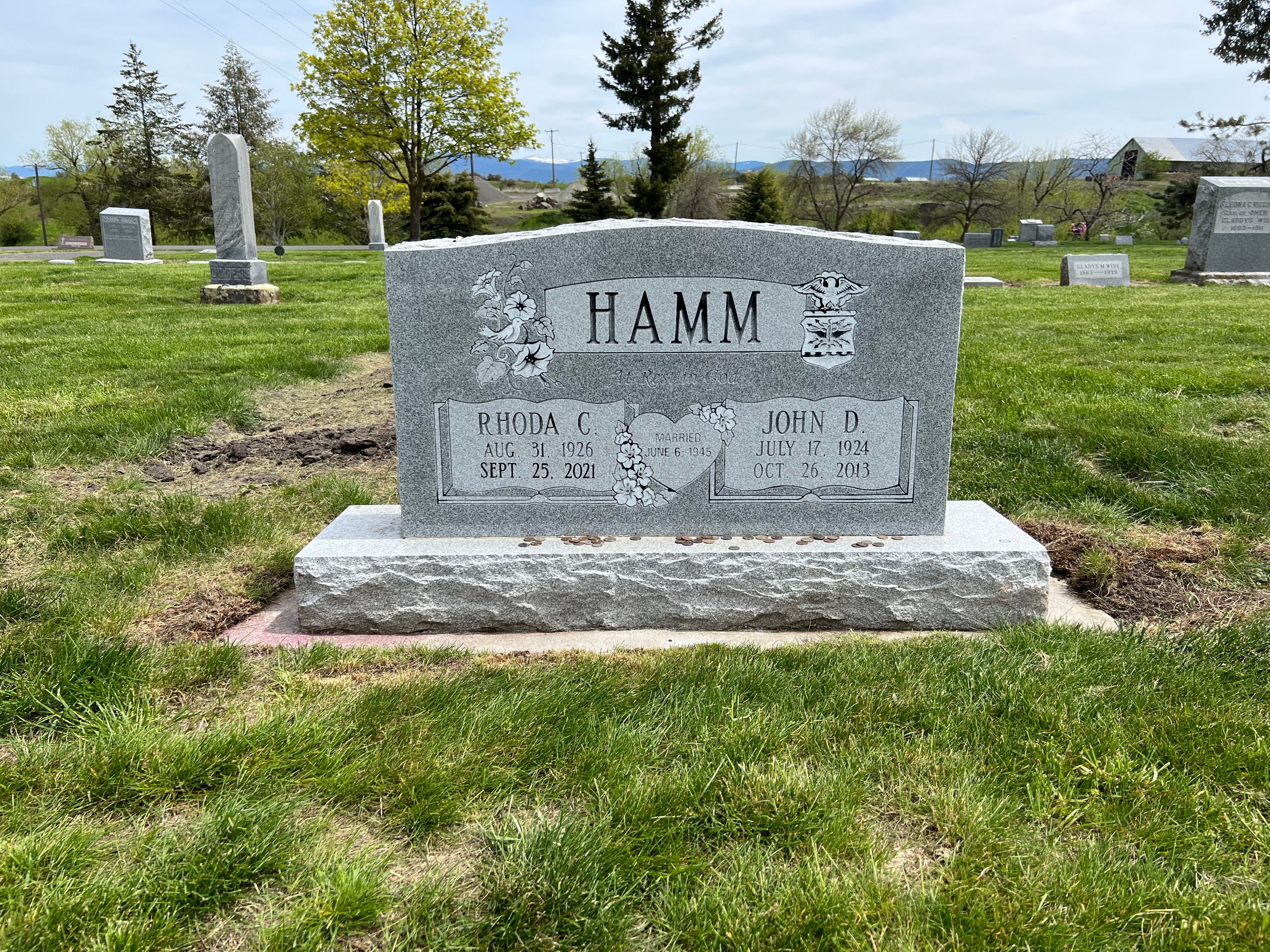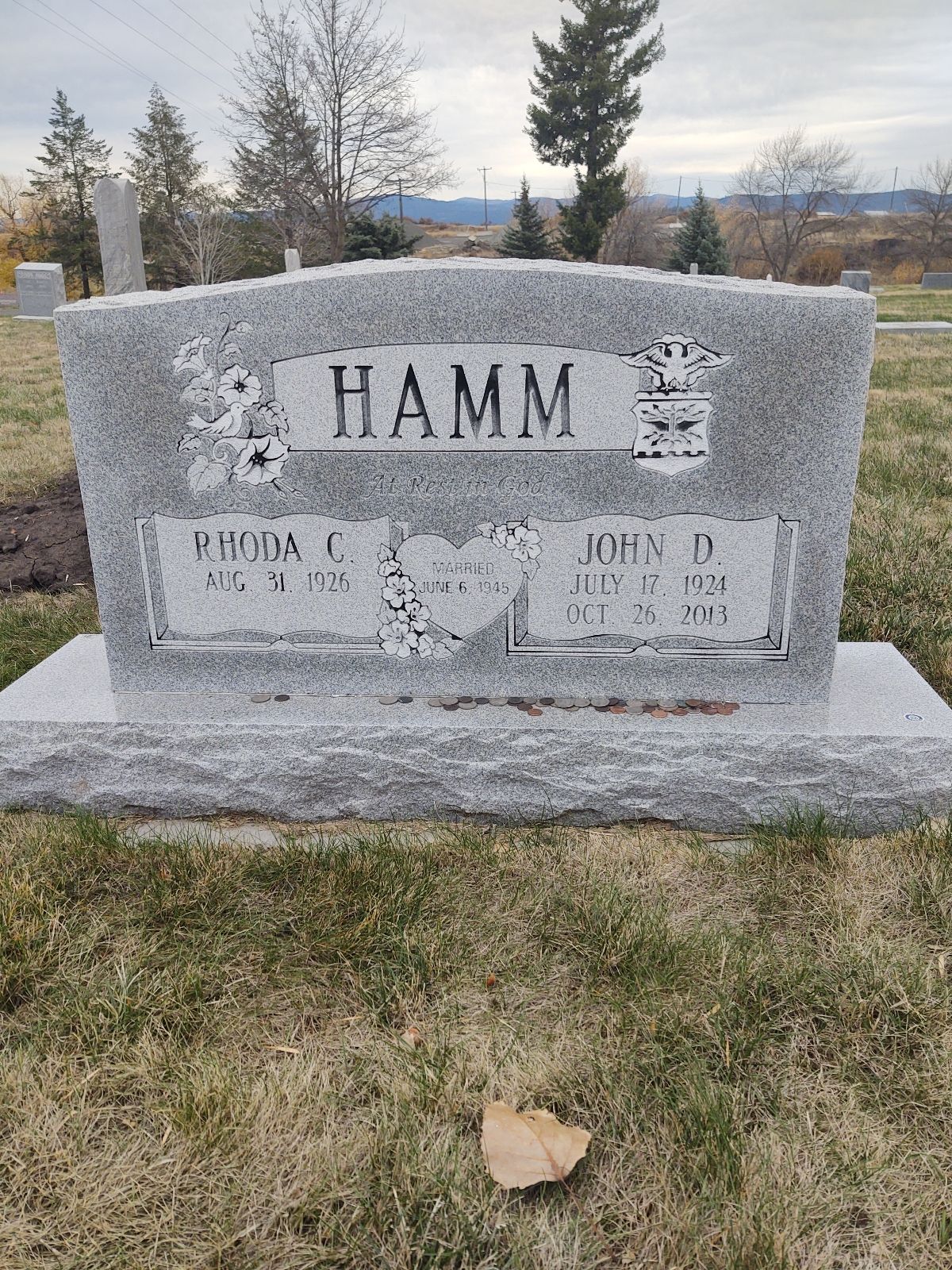After graduating from high school, he went to Alaska to work on the construction of the Alcan Highway from October 1942 to June 1943. During this time he was introduced, by mail, to Rhoda Stead, who wrote to him faithfully.
He returned home to enlist in the U.S. Army Air Corps. He earned his pilot's rating and was commissioned a second lieutenant on Feb. 2, 1945. He transitioned to flying B-25s at Douglas, Ariz., as the first step in the P-61 "Black Widow" night fighter program. As a result of the program cutback on V-E Day, John became a B-25 instructor, training Chinese pilots. During a much-anticipated furlough after flight school, he went home to Minnesota and met Rhoda face to face after two years of correspondence. They were married on June 6, 1945, in Douglas, Ariz.
After World War II, John was separated from active duty and went on reserve status. The Hamms moved to Minneapolis, where John attended Miller Vocational School and became an auto mechanic. He worked as a mechanic in northern Minnesota until he was recalled to the military in March of 1951 during the Korean War. John and Rhoda's three oldest boys, Mike, David and Tom, were born during their time in Minnesota. John served a short stint in Montgomery, Ala., before being sent on temporary duty assignment to Japan in 1952, he then received orders to K2, Korea, where he served as maintenance officer and flew C-45s. He commanded a detachment of the 7th Motor Transportation Squadron in Pusan, Korea, in the spring of 1953. He was shipped back to the states to El Paso, Texas, that summer. That fall, the family was reunited at John's new station at Pope Air Force Base in South Carolina, where he served as chief of vehicle operations and maintenance until his orders came to take over as the vehicle operations and maintenance officer for the Northeast Air Command in Newfoundland, Canada. It was here that the couple's fourth son, Mark was born and John was promoted to captain.
In 1958, the family moved to Turner Air Force Base, Albany, Ga., where John eventually served as the commander of the 1370th Supply Squadron. All throughout this time, John was maintaining his flight status in C-47s, C-45s, B-30s but mainly in C-130s. While in Georgia, they completed their family with the birth of their daughter, Debbie. In 1962, John was transferred to Ramstein Air Force Base, Germany, where he served as director of materiel 31st Weather Squadron. He was named, "Outstanding Supply Officer" for the year in 1962. In 1963, he was promoted to major and took over as the Atlantic Rescue Center plans officer, which included planning and staffing the support of NASA's Gemini project. He also coordinated the airlift of Americans (mostly missionaries) from the Belgian Congo during that country's civil war.
In 1965, the family moved to Orlando, Fla., where John would work as the aerospace plans officer-Air Rescue Service. This duty entailed "reviewing and coordinating activities associated with specific missions and personally directing and controlling recovery of the astronauts and capsules during NASA manned and unmanned spaceflight missions in the Apollo Space Program." According to Air Force documents, he "personally directed the air recovery force off Ascension Island during the Apollo 201 mission and was directly responsible for its location and timely recovery he personally participated in actual recovery missions during Gemini 4, 5, 6, 7, 8 and 9, either as the ARRS Controller in the Mission Control Center at Cape Kennedy or as the Mission Commander for ARRS aircraft in the primary recovery area." While in Florida, John was promoted to lieutenant colonel. In March of 1967, He was assigned to the top secret project "Phyllis Ann" at Nha Trang Air Base in Vietnam. He was an aircraft commander flying the EC-47 "Listening Ears" (combat reconnaissance), obtaining a squadron record of 173 combat missions, logging more than 1,200 combat flying hours and earning the Distinguished Flying Cross and the Air Medal a total of nine times in his flying career.
In 1968, John was assigned to the Alaskan Air Command at Elmendorf Air Force Base, Alaska, where he was director of inspection services operating as the chief inspector for the inspector general. In 1971, John was transferred to Davis-Monthan Air Force Base in Tucson, Ariz., where he was the base management and procedures officer. This move signified the end of his flying career, at which time he had been the first pilot qualified in 13 different aircraft. In 1974, John was assigned to Anderson Air Force Base, Guam, where he took over as the 8th Air Force director of supply and services. This ended up being one of his most interesting and challenging tours of duty as the end of the Vietnam era and brought the airlift evacuation of more than 100,000 Vietnamese and Cambodian refugees whose first stop was Guam. As director of supply and services, John was responsible not only for the logistics of transporting, feeding and housing the refugees, but also bringing home the war machines from Southeast Asia. Following on the heels of the refugee evacuation, Guam experienced an earthquake and then a devastating typhoon ransacked the entire island. These events required exceptional logistics and planning skills. John's commanding officer commented that, "Through his (John's) foresight and ingenuity, the 43rd SW was able to return to normal supply processing of requirements and accountability within nine days of the typhoon disaster. Lt. Col Hamm is unquestionably the most capable logistics officer I have ever had the pleasure to work with." In 1976, John assumed his last assignment as base chief of supply/commander of the 90th Supply Squadron at F.E. Warren Air Force Base in Cheyenne, Wyo. In his last Officer's Effectiveness Report, the base commander noted, "John Hamm is the epitome of the professional Air Force officer. His daily performance, integrity, military bearing and adherence to customs and courtesies is indeed inspirational. He is one of this Wing's most esteemed squadron commanders. His contributions and effective support will be sorely missed upon his retirement on January 1, 1979."
In his 35-year military career, John was awarded 22 medals, many of them more than once, and numerous awards and commendations. He logged more than 5,600 flight hours and maintained longtime military friendships right up to the time of his death. His love for his "troops" was evident in the many hours he spent counseling and advising those under his command and those junior and senior officers alike who often sought his advice and expertise. John enjoyed a long and vibrant retirement, camping, fishing, hunting and traveling, but he always took time to invest in serving others, whether it was working on people's cars, snow-blowing the neighbor's sidewalks, helping out and visiting elderly friends or planning field trips for the seniors at his church. He was a loving servant through and through. He served his churches as a deacon, Sunday school teacher, bus driver and Bible study leader for years. Throughout his life, he maintained a loving home environment and instilled in his five children his strong work ethic, generous spirit, the idea of personal responsibility and a good sense of humor, leaving them with the legacy of his love for family and his Lord and Savior, Jesus Christ. He loved and invested in his grandchildren though separated by many miles. He enjoyed a good Scandinavian joke and could make the sound of a train whistle in his throat, like you couldn't believe! He could drive you crazy with his attention to detail and make you darn glad of it when he made your old car purr like a kitten!
He and Rhoda celebrated 68 years of marriage in June of this year. In July, all of his children, many grandchildren, great-grandchildren and nieces gathered in Grangeville to celebrate his 89th birthday. The event was highlighted by a visit with the crew of the B-25 "Grumpy" at the War Bird weekend at the Grangeville airport and his picture on the front page of the Idaho County Free Press.
Survivors' names omitted per findagrave policy.
John was preceded in death by his parents, five sisters and two brothers.
Memorials are suggested to Samaritan's Purse Wounded Warriors project or the charity of your choice.
Lewiston Tribune October 29, 2013
------------------------------------------------------------
After graduating from high school, he went to Alaska to work on the construction of the Alcan Highway from October 1942 to June 1943. During this time he was introduced, by mail, to Rhoda Stead, who wrote to him faithfully.
He returned home to enlist in the U.S. Army Air Corps. He earned his pilot's rating and was commissioned a second lieutenant on Feb. 2, 1945. He transitioned to flying B-25s at Douglas, Ariz., as the first step in the P-61 "Black Widow" night fighter program. As a result of the program cutback on V-E Day, John became a B-25 instructor, training Chinese pilots. During a much-anticipated furlough after flight school, he went home to Minnesota and met Rhoda face to face after two years of correspondence. They were married on June 6, 1945, in Douglas, Ariz.
After World War II, John was separated from active duty and went on reserve status. The Hamms moved to Minneapolis, where John attended Miller Vocational School and became an auto mechanic. He worked as a mechanic in northern Minnesota until he was recalled to the military in March of 1951 during the Korean War. John and Rhoda's three oldest boys, Mike, David and Tom, were born during their time in Minnesota. John served a short stint in Montgomery, Ala., before being sent on temporary duty assignment to Japan in 1952, he then received orders to K2, Korea, where he served as maintenance officer and flew C-45s. He commanded a detachment of the 7th Motor Transportation Squadron in Pusan, Korea, in the spring of 1953. He was shipped back to the states to El Paso, Texas, that summer. That fall, the family was reunited at John's new station at Pope Air Force Base in South Carolina, where he served as chief of vehicle operations and maintenance until his orders came to take over as the vehicle operations and maintenance officer for the Northeast Air Command in Newfoundland, Canada. It was here that the couple's fourth son, Mark was born and John was promoted to captain.
In 1958, the family moved to Turner Air Force Base, Albany, Ga., where John eventually served as the commander of the 1370th Supply Squadron. All throughout this time, John was maintaining his flight status in C-47s, C-45s, B-30s but mainly in C-130s. While in Georgia, they completed their family with the birth of their daughter, Debbie. In 1962, John was transferred to Ramstein Air Force Base, Germany, where he served as director of materiel 31st Weather Squadron. He was named, "Outstanding Supply Officer" for the year in 1962. In 1963, he was promoted to major and took over as the Atlantic Rescue Center plans officer, which included planning and staffing the support of NASA's Gemini project. He also coordinated the airlift of Americans (mostly missionaries) from the Belgian Congo during that country's civil war.
In 1965, the family moved to Orlando, Fla., where John would work as the aerospace plans officer-Air Rescue Service. This duty entailed "reviewing and coordinating activities associated with specific missions and personally directing and controlling recovery of the astronauts and capsules during NASA manned and unmanned spaceflight missions in the Apollo Space Program." According to Air Force documents, he "personally directed the air recovery force off Ascension Island during the Apollo 201 mission and was directly responsible for its location and timely recovery he personally participated in actual recovery missions during Gemini 4, 5, 6, 7, 8 and 9, either as the ARRS Controller in the Mission Control Center at Cape Kennedy or as the Mission Commander for ARRS aircraft in the primary recovery area." While in Florida, John was promoted to lieutenant colonel. In March of 1967, He was assigned to the top secret project "Phyllis Ann" at Nha Trang Air Base in Vietnam. He was an aircraft commander flying the EC-47 "Listening Ears" (combat reconnaissance), obtaining a squadron record of 173 combat missions, logging more than 1,200 combat flying hours and earning the Distinguished Flying Cross and the Air Medal a total of nine times in his flying career.
In 1968, John was assigned to the Alaskan Air Command at Elmendorf Air Force Base, Alaska, where he was director of inspection services operating as the chief inspector for the inspector general. In 1971, John was transferred to Davis-Monthan Air Force Base in Tucson, Ariz., where he was the base management and procedures officer. This move signified the end of his flying career, at which time he had been the first pilot qualified in 13 different aircraft. In 1974, John was assigned to Anderson Air Force Base, Guam, where he took over as the 8th Air Force director of supply and services. This ended up being one of his most interesting and challenging tours of duty as the end of the Vietnam era and brought the airlift evacuation of more than 100,000 Vietnamese and Cambodian refugees whose first stop was Guam. As director of supply and services, John was responsible not only for the logistics of transporting, feeding and housing the refugees, but also bringing home the war machines from Southeast Asia. Following on the heels of the refugee evacuation, Guam experienced an earthquake and then a devastating typhoon ransacked the entire island. These events required exceptional logistics and planning skills. John's commanding officer commented that, "Through his (John's) foresight and ingenuity, the 43rd SW was able to return to normal supply processing of requirements and accountability within nine days of the typhoon disaster. Lt. Col Hamm is unquestionably the most capable logistics officer I have ever had the pleasure to work with." In 1976, John assumed his last assignment as base chief of supply/commander of the 90th Supply Squadron at F.E. Warren Air Force Base in Cheyenne, Wyo. In his last Officer's Effectiveness Report, the base commander noted, "John Hamm is the epitome of the professional Air Force officer. His daily performance, integrity, military bearing and adherence to customs and courtesies is indeed inspirational. He is one of this Wing's most esteemed squadron commanders. His contributions and effective support will be sorely missed upon his retirement on January 1, 1979."
In his 35-year military career, John was awarded 22 medals, many of them more than once, and numerous awards and commendations. He logged more than 5,600 flight hours and maintained longtime military friendships right up to the time of his death. His love for his "troops" was evident in the many hours he spent counseling and advising those under his command and those junior and senior officers alike who often sought his advice and expertise. John enjoyed a long and vibrant retirement, camping, fishing, hunting and traveling, but he always took time to invest in serving others, whether it was working on people's cars, snow-blowing the neighbor's sidewalks, helping out and visiting elderly friends or planning field trips for the seniors at his church. He was a loving servant through and through. He served his churches as a deacon, Sunday school teacher, bus driver and Bible study leader for years. Throughout his life, he maintained a loving home environment and instilled in his five children his strong work ethic, generous spirit, the idea of personal responsibility and a good sense of humor, leaving them with the legacy of his love for family and his Lord and Savior, Jesus Christ. He loved and invested in his grandchildren though separated by many miles. He enjoyed a good Scandinavian joke and could make the sound of a train whistle in his throat, like you couldn't believe! He could drive you crazy with his attention to detail and make you darn glad of it when he made your old car purr like a kitten!
He and Rhoda celebrated 68 years of marriage in June of this year. In July, all of his children, many grandchildren, great-grandchildren and nieces gathered in Grangeville to celebrate his 89th birthday. The event was highlighted by a visit with the crew of the B-25 "Grumpy" at the War Bird weekend at the Grangeville airport and his picture on the front page of the Idaho County Free Press.
Survivors' names omitted per findagrave policy.
John was preceded in death by his parents, five sisters and two brothers.
Memorials are suggested to Samaritan's Purse Wounded Warriors project or the charity of your choice.
Lewiston Tribune October 29, 2013
------------------------------------------------------------
Family Members
Sponsored by Ancestry
Advertisement
Advertisement
















